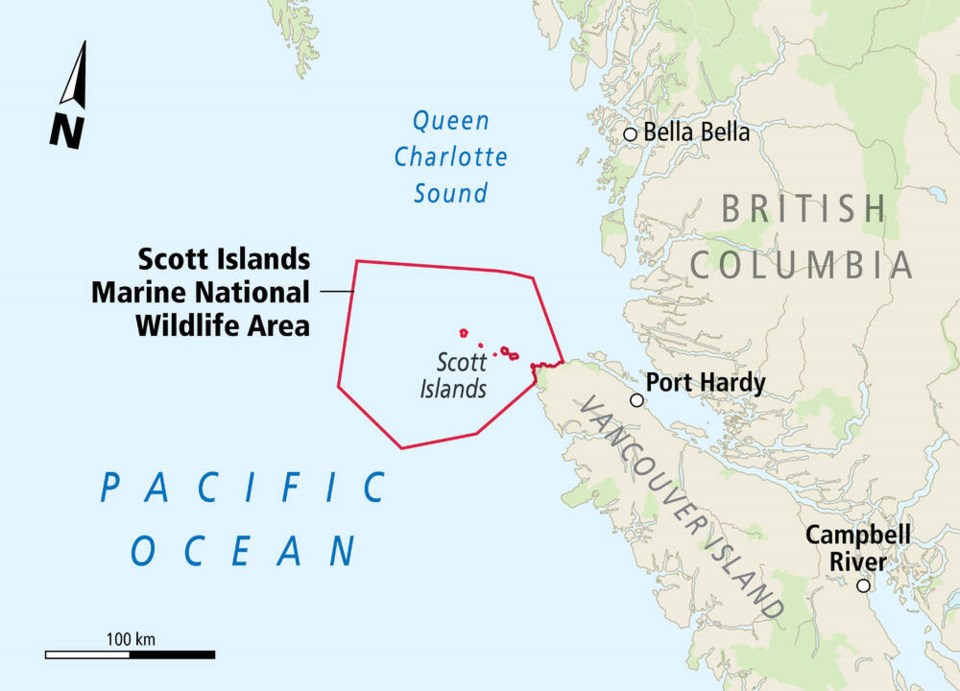As the cruise-ship season starts to ramp up along the West Coast, an environmental group is calling on the federal government to tighten its rules and raise minimum standards around vessels dumping sewage and other waste in protected marine areas.
World Wildlife Fund Canada said in a report this week that all types of ships operating in Canadian waters generate — and potentially dump — 147 billion litres of operational waste each year, the equivalent of 59,000 Olympic-sized swimming pools.
The report said that nearly 10 per cent of what flows overboard goes into marine protected areas and other protected waters. It says one of the most at-risk areas in Canadian waters is the Scott Islands, the first marine National Wildlife Area established by the federal government in 2018.
Covering 11,546 square kilometres off north Vancouver Island, the five Scott Islands are a key ecological breeding and nesting habitat for 40 per cent of the province’s seabirds, including 90 per cent of Canada’s tufted puffins and 95 per cent of Pacific Canada’s common murres.
The area is also teeming with whales and stellar sea lions — and along the major cruise-ship route to Alaska.
After being shut down for two years because of the pandemic, the route will be active this year, with the large passenger ships plying B.C. coastal waters from early April through to October. In Victoria, 350 ship calls are scheduled for vessels sailing to Alaska.
WWF-Canada based its report on 2019 data from movements of 5,546 ships in Canadian waters, and the four major waste streams those ships created, where waste is likely dumped and by what types of vessels.
The waste streams in the study include sewage; toxic scrubber wash water; grey water from ship sinks, showers and laundries; and bilge waters that contain fuels and oils.
WWF-Canada said cruise ships are the top producers of the four waste streams, despite making up only 2% of the ships in its analysis. The analysis involved the movements of several types of vessels, from bulk carriers, oil tankers and cargo ships to ferries, fishing craft and tugboats.
WWF-Canada said the federal government has yet to follow through on a three-year-old commitment to bring in new regulations on what waste ships can release into the oceans, and that lack of progress is allowing ships to keep releasing wastewater.
“We don’t have the kind of regulations we need that would ban this kind of dumping,” said Kim Dunn, a co-author of the report.
Dunn said Ottawa promised in 2019 to draft rules that would define what kind of wastewater could be dumped into oceans and where that would be allowed. “We don’t yet see that commitment,” Dunn said.
Without clear definitions, releasing many types of waste into seawater remains legal.
Almost all of the wastewater — 97 per cent, according to the report — comes from ship scrubbers, which remove sulphur and other contaminants from smokestacks. That wastewater is acidic and carries heavy metals and hydrocarbons that are known carcinogens.
About two-thirds of the scrubber wastewater that enters Canadian waters comes from cruise ships, the report added.
Ottawa announced in April 2019 new “minimum standards” that prohibit oil and gas activities, mining, bottom trawling and dumping in marine protected areas. But the report said while a ban on dumping may seem straightforward, there is currently no standardized definition of what dumping actually means in the context of marine protection in Canada.
“As a result, dumping from ships in protected areas remains subject to interpretation,” said the report.
Dunn said a comprehensive definition of dumping is needed, so there are minimum standards in all of Canada’s marine protected areas that would prohibit the discharge of operational waste from ships. “We know from the science that all of the waste streams studied in this report are harmful.”
Comment from the shipping industry was not immediately available.
Transport Canada spokeswoman Sau Sau Liu said the government is consulting with industry and other stakeholders on new rules.
“In light of the 2019 federal announcement to establish minimum standards for [Marine Protected Areas], including a prohibition on ‘dumping,’ Transport Canada is examining the operational and technical feasibility of enhancing existing vessel operational discharge requirements under these regulations,” she said in an email.
Transport Canada said regulations on grey water, sewage and bilge contents in southern waters are aligned with international rules. In the North, the Arctic Waters Pollution Prevention Act prohibits all waste discharge.
While that act does prevent ships from releasing bilge water or other oil-containing water into the Arctic, the report says those rules are ambiguous for other wastes.
“Ships use scrubbers and discharge wash water in the region, but the legality of this practice is an open question due to regulatory inconsistencies and conflicts with accepted practices,” Sam Davin, a co-author of the WWF-Canada report, said in an email. “This inconsistency leaves room for ambiguity in enforcement.”
Davin said grey-water release in the Arctic is in a similar limbo.
“There are no reception facilities in the Arctic capable of handling large volumes of grey water and ships do not generally have the ability to retain their grey water beyond a few days,” Davin wrote. “Additionally, Transport Canada has neither approved nor certified any grey water treatment system for use in the Canadian Arctic.”





